Cylinder Head -- Inspection |
| 1. INSPECT CYLINDER HEAD SUB-ASSEMBLY |
Clean the cylinder head.
Using a gasket scraper, remove all the gasket material from the cylinder block contact surface.
- NOTICE:
- Be careful not to scratch the cylinder block contact surface.
Using a wire brush, remove all the carbon from the combustion chambers.
- NOTICE:
- Be careful not to scratch the cylinder block contact surface.
Using a valve guide bushing brush and solvent, clean all the guide bushes.
Using a soft brush and solvent, thoroughly clean the cylinder head.
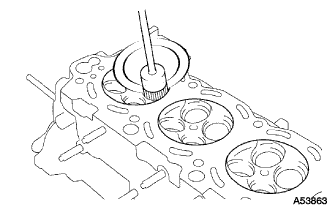
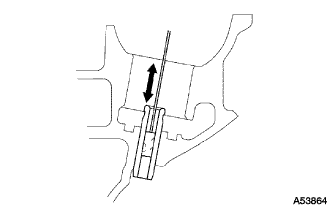
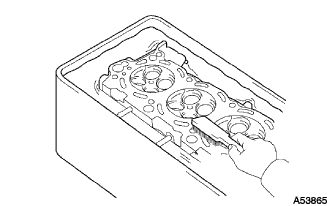
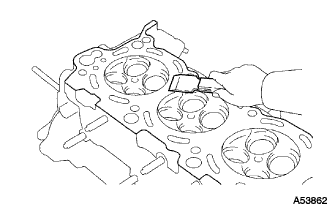 |
Inspect for flatness.
Using a precision straightedge and feeler gauge, measure the surfaces contacting the cylinder block and the manifolds for warpage.
- Maximum warpage:
Item Specified Condition Cylinder block surface 0.05 mm (0.0020 in.) Intake manifold surface 0.10 mm (0.0039 in.) Exhaust manifold surface 0.10 mm (0.0039 in.)
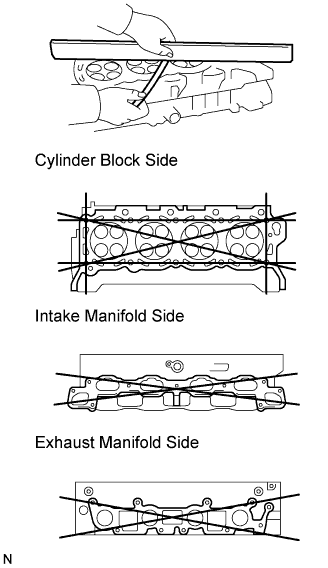 |
Inspect the cylinder head for cracks.
Using a dye penetrant, check the combustion chamber, intake ports, exhaust ports and cylinder block surface for cracks.
- If the cylinder head is cracked, replace it.
- If the cylinder head is cracked, replace it.
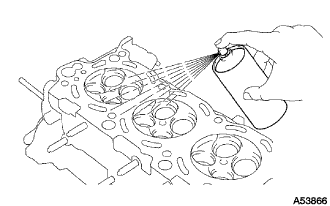 |
| 2. INSPECT INTAKE VALVE |
Clean the valves.
Using a gasket scraper, chip off any carbon from the valve head.
Using a wire brush, thoroughly clean the valve.
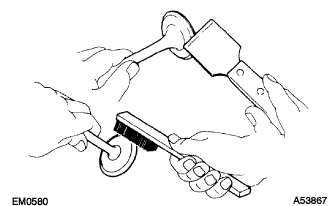 |
Using a micrometer, measure the diameter of the valve stem.
- Valve stem diameter:
- 5.470 to 5.485 mm (0.2154 to 0.2159 in.)
- If the diameter is greater than the maximum, replace the valve and guide bushing.
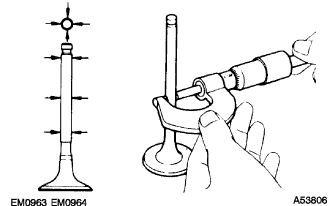 |
Check the valve face angle.
Grind the valve sufficiently to remove pits and carbon.
Check that the valve is ground to the correct valve face angle.
- Valve face angle:
- 44.5°
- If the valve face is worn, replace the valve.
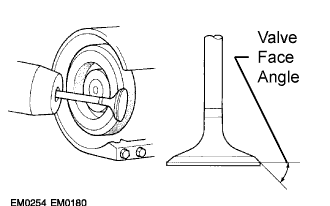 |
Check the valve head margin thickness.
- Standard margin thickness:
- 1.0 mm (0.039 in.)
- Minimum margin thickness:
- 0.5 mm (0.020 in.)
- If the margin thickness is less than the minimum, replace the valve.
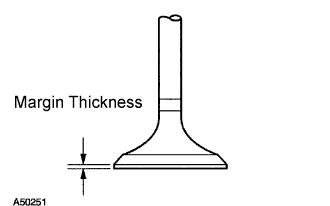 |
Check the valve overall length.
- Standard overall length:
- 94.80 to 95.30 mm (3.7323 to 3.7520 in.)
- Minimum overall length:
- 94.55 mm (3.7224 in.)
- If the overall length is less than the minimum, replace the valve.
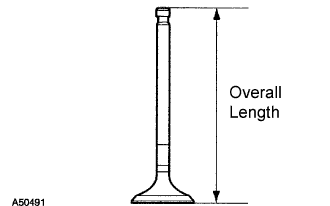 |
Check the surface of the valve stem tip for wear.
- If the valve stem tip is worn, resurface the tip with a grinder or replace the valve.
- NOTICE:
- Be careful not to grind off more than the minimum.
- If the valve stem tip is worn, resurface the tip with a grinder or replace the valve.
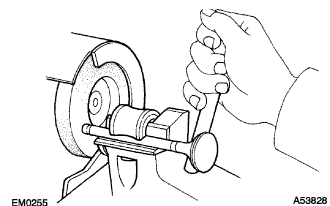 |
| 3. INSPECT EXHAUST VALVE |
Clean the valves.
Using a gasket scraper, chip off any carbon from the valve head.
Using a wire brush, thoroughly clean the valve.
 |
Using a micrometer, measure the diameter of the valve stem.
- Valve stem diameter:
- 5.465 to 5.480 mm (0.2152 to 0.2157 in.)
- If the clearance is greater than the maximum, replace the valve and guide bushing.
 |
Check the valve face angle.
Grind the valve sufficiently to remove pits and carbon.
Check that the valve is ground to the correct valve face angle.
- Valve face angle:
- 44.5°
- If the valve face is worn, replace the valve.
 |
Check the valve head margin thickness.
- Standard margin thickness:
- 1.0 mm (0.039 in.)
- Minimum margin thickness:
- 0.5 mm (0.020 in.)
- If the margin thickness is less than the minimum, replace the valve.
 |
Check the overall valve length.
- Standard overall length:
- 94.85 to 95.35 mm (3.7342 to 3.7539 in.)
- Minimum overall length:
- 94.60 mm (3.7244 in.)
- If the overall length is less than the minimum, replace the valve.
 |
Check the surface of the valve stem tip for wear.
- If the valve stem tip is worn, resurface the tip with a grinder or replace the valve.
- NOTICE:
- Be careful not to grind off more than the minimum.
- If the valve stem tip is worn, resurface the tip with a grinder or replace the valve.
 |
| 4. INSPECT INNER COMPRESSION SPRING |
Using steel squares, measure the deviation of the spring.
- Maximum deviation:
- 2.0 mm (0.079 in.)
- If the deviation is greater than the maximum, replace the spring.
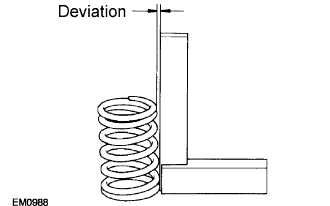 |
Using a vernier caliper, measure the free length of the spring.
- Free length:
- 51.29 to 51.39 mm (2.0193 to 2.0232 in.)
- If the free length is not as specified, replace the spring.
 |
Using a spring tester, measure the tension of the valve spring at the specified installed length.
- Installed tension:
- 209 to 226 N (21.3 to 23.0 kgf, 45.9 to 50.7 lbf) at 33.40 mm (1.3150 in.)
- If the installed tension is not as specified, replace the valve spring.
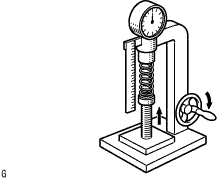 |
| 5. INSPECT INTAKE VALVE GUIDE BUSH |
Using a caliper gauge, measure the inside diameter of the guide bush.
- Bush inside diameter:
- 5.510 to 5.530 mm (0.2169 to 0.2177 in.)
- If the diameter is not as specified, check the oil clearance.
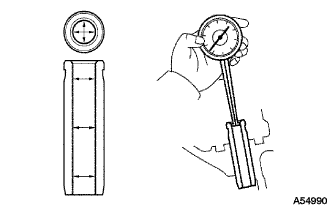 |
Subtract the valve stem diameter measurement from the guide bush inside diameter measurement.
- Standard oil clearance:
- 0.025 to 0.060 mm (0.0010 to 0.0024 in.)
- Maximum oil clearance:
- 0.08 mm (0.0031 in.)
- If the clearance is greater than the maximum, replace the valve and guide bush.
| 6. INSPECT EXHAUST VALVE GUIDE BUSH |
Using a caliper gauge, measure the inside diameter of the guide bush.
- Bush inside diameter:
- 5.510 to 5.530 mm (0.2169 to 0.2177 in.)
- If the diameter is not as specified, check the oil clearance.
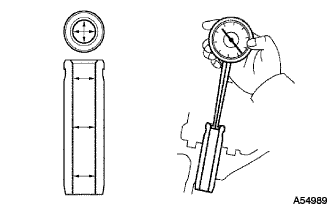 |
Subtract the valve stem diameter measurement from the guide bush inside diameter measurement.
- Standard oil clearance:
- 0.030 to 0.065 mm (0.0012 to 0.0026 in.)
- Maximum oil clearance:
- 0.10 mm (0.0039 in.)
- If the clearance is greater than the maximum, replace the valve and guide bush.
| 7. INSPECT INTAKE VALVE SEAT |
Using a 45° carbon cutter, resurface the valve seats.
- HINT:
- Only remove the amount of metal necessary to clean the seats.
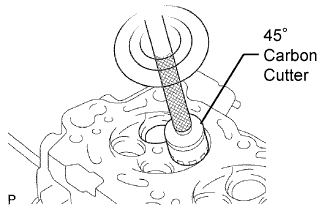 |
Check the valve seating position.
Apply a light coat of Prussian blue (or white lead) to the valve face.
Lightly press the valve against the seat. Do not rotate the valve.
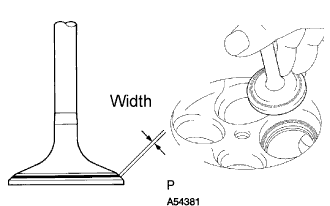 |
Check the valve face and seat for the following:
If blue appears 360° around the face, the valve is concentric. If not, replace the valve.
If blue appears 360° around the valve seat, the guide and face are concentric. If not, resurface the seat.
Check that the seat contact is in the middle of the valve face and has the width below.
- Width:
- 1.0 to 1.4 mm (0.039 to 0.055 in.)
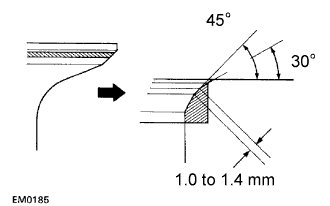
- If not, correct the exhaust valve seats as follows:
If the seating is too high on the valve face:
- Use 30° and 45° cutters to correct the seat.
- Use 30° and 45° cutters to correct the seat.
If the seating is too low on the valve face:
- Use 60° and 45° cutters to correct the seat.
- Use 60° and 45° cutters to correct the seat.
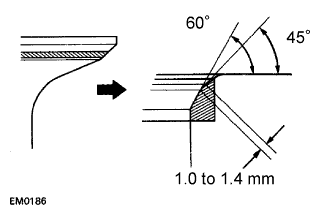 |
Handrub the valve and valve seat with an abrasive compound.
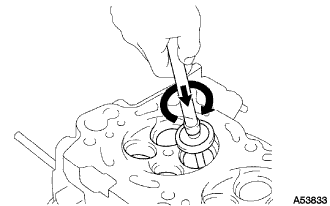 |
After handrubbing, clean the valve and valve seat.
| 8. INSPECT EXHAUST VALVE SEAT |
Using a 45° carbon cutter, resurface the valve seats.
- HINT:
- Only remove the amount of metal necessary to clean the seats.
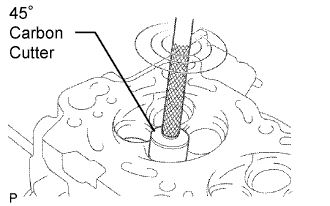 |
Check the valve seating position.
Apply a light coat of Prussian blue (or white lead) to the valve face.
Lightly press the valve against the seat. Do not rotate the valve.
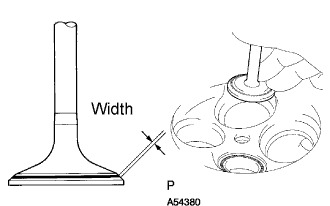 |
Check the valve face and seat for the following:
If blue appears 360° around the face, the valve is concentric. If not, replace the valve.
If blue appears 360° around the valve seat, the guide and face are concentric. If not, resurface the seat.
Check that the seat contact is in the middle of the valve face and has the width below.
- Width:
- 1.0 to 1.4 mm (0.039 to 0.055 in.)

- If not, correct the exhaust valve seats as follows:
If the seating is too high on the valve face:
- Use 30° and 45° cutters to correct the seat.
- Use 30° and 45° cutters to correct the seat.
If the seating is too low on the valve face:
- Use 60° and 45° cutters to correct the seat.
- Use 60° and 45° cutters to correct the seat.
 |
Handrub the valve and valve seat with an abrasive compound.
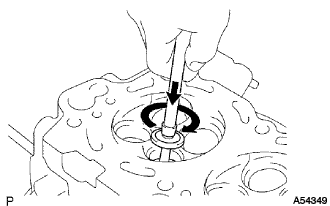 |
After handrubbing, clean the valve and valve seat.
| 9. INSPECT VALVE LIFTER |
Using a micrometer, measure the lifter diameter at a position 10.5 to 14.5 mm (0.413 to 0.570 in.) from the top surface.
- Lifter diameter:
- 30.968 to 30.976 mm (1.2192 to 1.2195 in.)
- If the lifter diameter is not as specified, check the oil clearance.
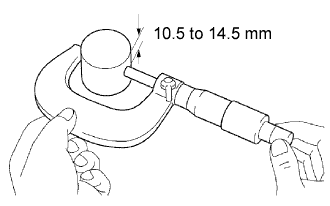 |
Using a caliper gauge, measure the lifter bore diameter of the cylinder head.
- Lifter bore diameter:
- 31.000 to 31.016 mm (1.2205 to 1.2211 in.)
- If the lifter diameter is not as specified, check the oil clearance.
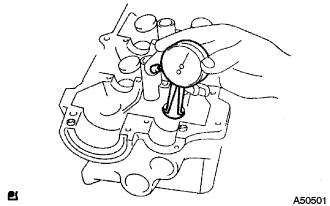 |
Subtract the lifter diameter measurement from the lifter bore diameter measurement.
- Standard oil clearance:
- 0.024 to 0.048 mm (0.0009 to 0.0018 in.)
- Maximum oil clearance:
- 0.07 mm (0.0028 in.)
- If the oil clearance is greater than the maximum, replace the lifter. If necessary, replace the cylinder head.
| 10. INSPECT CAMSHAFT |
Inspect the circle runout.
Place the camshaft on V-blocks.
Using a dial indicator, measure the circle runout at the center journal.
- Maximum circle runout:
- 0.08 mm (0.0031 in.)
- If the circle runout is greater than the maximum, replace the camshaft.
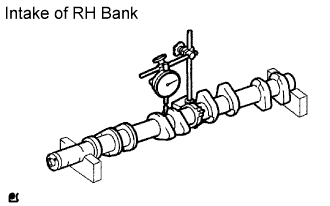 |
Using a micrometer, measure the cam lobe height.
- Standard cam lobe height:
- 42.610 to 42.710 mm (1.6776 to 1.6815 in.)
- Minimum cam lobe height:
- 42.46 mm (1.6717 in.)
- If the cam lobe height is less than the minimum, replace the camshaft.
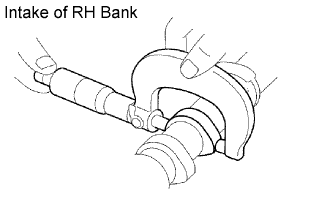 |
Inspect the journal diameter of the camshaft.
Using a micrometer, measure the journal diameter of the camshaft for the camshaft bearing.
- Journal diameter:
- 26.954 to 26.970 mm (1.0612 to 1.0618 in.)
- If the journal diameter is not as specified, check the oil clearance.
Using a micrometer, measure the journal diameter for the camshaft timing tube.
- Journal diameter:
- 30.984 to 31.000 mm (1.2198 to 1.2205 in.)
- If the journal diameter is not as specified, check the oil clearance.
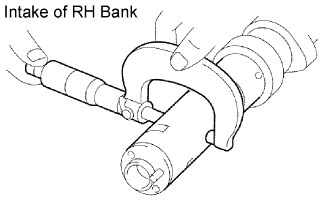
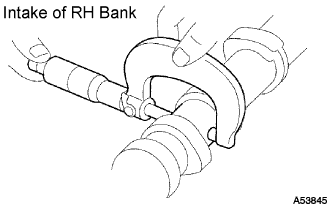 |
Inspect the journal diameter of the camshaft timing tube.
Using a micrometer, measure the journal diameter.
- Journal diameter:
- 39.955 to 39.964 mm (1.5730 to 1.5734 in.)
- If the journal diameter is not as specified, check the oil clearance.
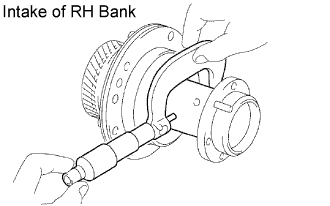 |
Install the camshaft timing tube to the camshaft, and check that the timing tube turns smoothly.
- If necessary, replace the timing tube and camshaft.
- If necessary, replace the timing tube and camshaft.
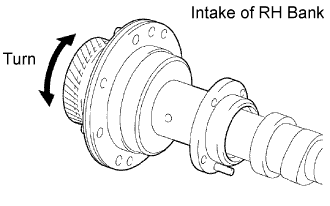 |
Check the oil clearance.
Install the camshaft timing tube to the camshaft.
Clean the bearing caps and journals.
Check the bearings for flaking and scoring.
- If the bearings are damaged, replace the bearing caps and cylinder head as a set.
- If the bearings are damaged, replace the bearing caps and cylinder head as a set.
Place the camshaft on the cylinder head.
Lay a strip of Plastigage across each of the journals.
Install the bearing caps.
- NOTICE:
- Do not turn the camshaft.
Remove the bearing caps.
Measure the Plastigage at its widest point.
- Standard oil clearance:
Journal Oil clearance Camshaft journal 0.030 to 0.067 mm (0.0012 to 0.0026 in.) Camshaft timing tube journal 0.036 to 0.057 mm (0.0014 to 0.0022 in.)
- Maximum oil clearance:
Journal Oil clearance Camshaft journal 0.100 mm (0.0039 in.) Camshaft timing tube journal 0.075 mm (0.0030 in.)
- If the oil clearance is greater than the maximum, replace the camshaft and timing tube. If necessary, replace the bearing caps and cylinder head as a set.
Completely remove the Plastigage.
Remove the camshaft.
Remove the camshaft timing tube from the camshaft.
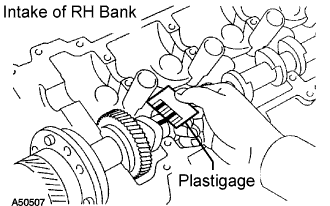
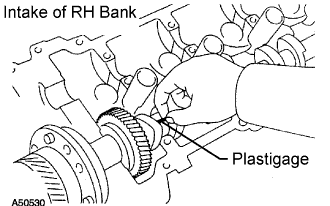 |
Check the thrust clearance.
Install the camshaft timing tube to the camshaft.
Install the camshaft.
Using a dial indicator, measure the thrust clearance while moving the camshaft back and forth.
- Standard thrust clearance:
- 0.060 to 0.100 mm (0.0024 to 0.0039 in.)
- Maximum thrust clearance:
- 0.13 mm (0.0051 in.)
- If the thrust clearance is greater than the maximum, replace the camshaft. If necessary, replace the bearing caps and cylinder head as a set.
Remove the camshaft.
Remove the camshaft timing tube from the camshaft.
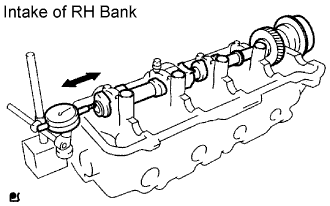 |
Check the gear backlash.
Install the drive gear to the camshaft timing tube.
Install the camshaft timing tube to the camshaft.
Install the camshaft and No. 2 camshaft without installing the camshaft sub-gear and front bearing cap.
Using a dial indicator, measure the backlash.
- Standard backlash:
- 0.020 to 0.200 mm (0.0008 to 0.0079 in.)
- Maximum backlash:
- 0.30 mm (0.0118 in.)
- If the backlash is greater than the maximum, replace the drive gear and No. 2 camshaft.
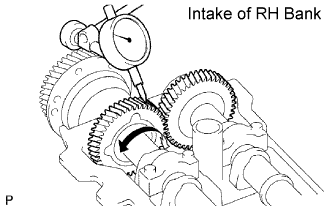 |
Remove the camshaft and No. 2 camshaft.
Remove the camshaft timing tube from the camshaft.
Remove the drive gear from the camshaft timing tube.
| 11. INSPECT NO. 2 CAMSHAFT |
Inspect the circle runout.
Place the camshaft on V-blocks.
Using a dial indicator, measure the circle runout at the center journal.
- Maximum circle runout:
- 0.08 mm (0.0031 in.)
- If the circle runout is greater than the maximum, replace the No. 2 camshaft.
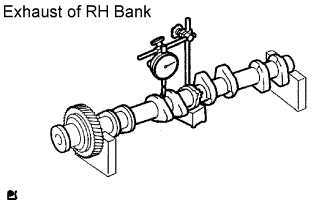 |
Using a micrometer, measure the cam lobe height.
- Standard cam lobe height:
- 42.630 to 42.730 mm (1.6783 to 1.6823 in.)
- Minimum cam lobe height:
- 42.48 mm (1.6724 in.)
- If the cam lobe height is less than the minimum, replace the No. 2 camshaft.
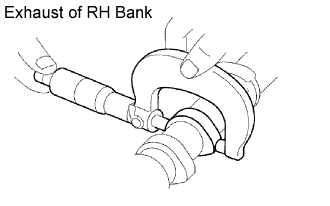 |
Using a micrometer, measure the journal diameter.
- Journal diameter:
- 26.954 to 26.970 mm (1.0612 to 1.0618 in.)
- If the journal diameter is not as specified, check the oil clearance.
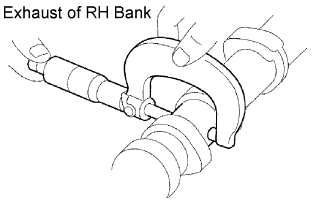 |
Check the oil clearance.
Clean the bearing caps and journals.
Check the bearings for flaking and scoring.
- If the bearings are damaged, replace the bearing caps and cylinder head as a set.
- If the bearings are damaged, replace the bearing caps and cylinder head as a set.
Place the No. 2 camshaft on the cylinder head.
Lay a strip of Plastigage across each of the journals.
Install the bearing caps.
- NOTICE:
- Be careful not to turn the No. 2 camshaft.
Remove the bearing caps.
Measure the Plastigage at its widest point.
- Standard oil clearance:
- 0.030 to 0.067 mm (0.0012 to 0.0026 in.)
- Maximum oil clearance:
- 0.100 mm (0.0039 in.)
- If the oil clearance is greater than the maximum, replace the No. 2 camshaft. If necessary, replace the bearing caps and cylinder head as a set.
Completely remove the Plastigage.
Remove the No. 2 camshaft.
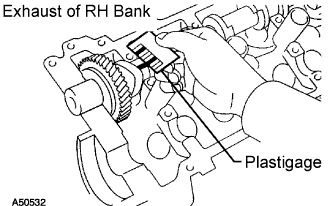
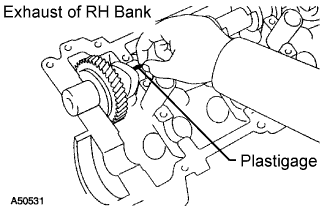 |
Check the thrust clearance.
Install the camshaft.
Using a dial indicator, measure the thrust clearance while moving the camshaft back and forth.
- Standard thrust clearance:
- 0.030 to 0.075 mm (0.0012 to 0.0030 in.)
- Maximum thrust clearance:
- 0.12 mm (0.0047 in.)
- If the thrust clearance is greater than the maximum, replace the No. 2 camshaft. If necessary, replace the bearing caps and cylinder head as a set.
Remove the No. 2 camshaft.
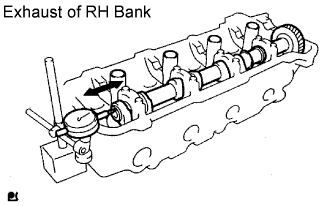 |
| 12. INSPECT NO. 3 CAMSHAFT SUB-ASSEMBLY |
Inspect the circle runout.
Place the camshaft on V-blocks.
Using a dial indicator, measure the circle runout at the center journal.
- Maximum circle runout:
- 0.08 mm (0.0031 in.)
- If the circle runout is greater than the maximum, replace the No. 3 camshaft.
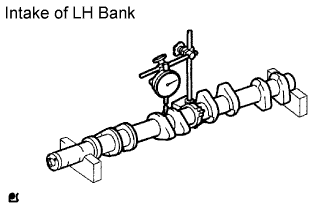 |
Using a micrometer, measure the cam lobe height.
- Standard cam lobe height:
- 42.610 to 42.710 mm (1.6776 to 1.6815 in.)
- Minimum cam lobe height:
- 42.46 mm (1.6717 in.)
- If the cam lobe height is less than the minimum, replace the No. 3 camshaft.
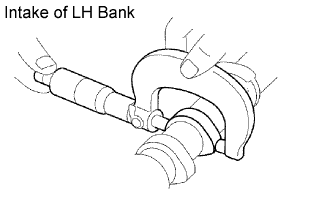 |
Inspect the journal diameter of the camshaft.
Using a micrometer, measure the journal diameter of the No. 3 camshaft for the camshaft bearing.
- Journal diameter:
- 26.954 to 26.970 mm (1.0612 to 1.0618 in.)
- If the journal diameter is not as specified, check the oil clearance.
Using a micrometer, measure the journal diameter for the camshaft timing tube.
- Journal diameter:
- 30.984 to 31.000 mm (1.2198 to 1.2205 in.)
- If the journal diameter is not as specified, check the oil clearance.

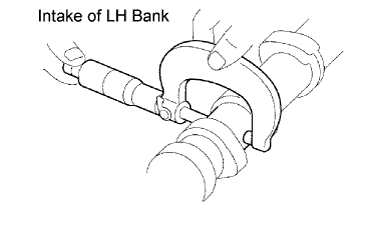 |
Inspect the journal diameter of the camshaft timing tube.
Using a micrometer, measure the journal diameter.
- Journal diameter:
- 39.955 to 39.964 mm (1.5730 to 1.5734 in.)
- If the journal diameter is not as specified, check the oil clearance.
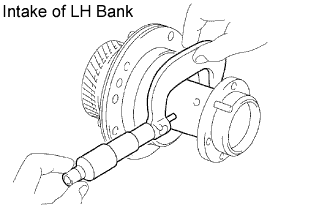 |
Install the timing tube to the No. 3 camshaft, and check the timing tube turns smoothly.
- If necessary, replace the timing tube and No. 3 camshaft.
- If necessary, replace the timing tube and No. 3 camshaft.
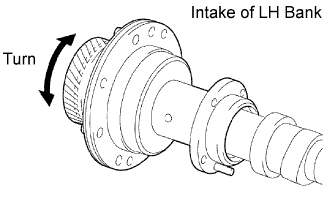 |
Check the oil clearance.
Install the camshaft timing tube to the No. 3 camshaft.
Clean the bearing caps and journals.
Check the bearings for flaking and scoring.
- If the bearings are damaged, replace the bearing caps and cylinder head as a set.
- If the bearings are damaged, replace the bearing caps and cylinder head as a set.
Place the No. 3 camshaft on the cylinder head.
Lay a strip of Plastigage across each of the journals.
Install the bearing caps.
- NOTICE:
- Be careful not to turn the camshaft.
Remove the bearing caps.
Measure the Plastigage at its widest point.
- Standard oil clearance:
Journal Oil clearance Camshaft journal 0.030 to 0.067 mm (0.0012 to 0.0026 in.) Camshaft timing tube journal 0.036 to 0.057 mm (0.0014 to 0.0022 in.)
- Maximum oil clearance:
Journal Oil clearance Camshaft journal 0.100 mm (0.0039 in.) Camshaft timing tube journal 0.075 mm (0.0030 in.)
- If the oil clearance is greater than the maximum, replace the No. 3 camshaft and timing tube. If necessary, replace the bearing caps and cylinder head as a set.
Completely remove the Plastigage.
Remove the camshaft.
Remove the camshaft timing tube from the No. 3 camshaft.
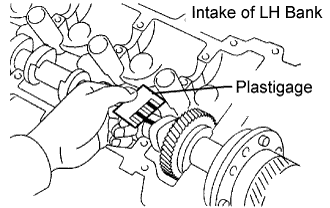
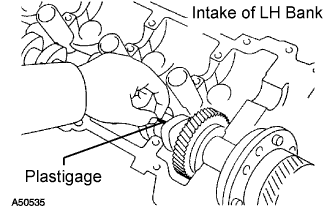 |
Check the thrust clearance.
Install the camshaft timing tube to the No. 3 camshaft.
Install the No. 3 camshaft.
Using a dial indicator, measure the thrust clearance while moving the No. 3 camshaft back and forth.
- Standard thrust clearance:
- 0.060 to 0.100 mm (0.0024 to 0.0039 in.)
- Maximum thrust clearance:
- 0.13 mm (0.0051 in.)
- If the thrust clearance is greater than the maximum, replace the No. 3 camshaft. If necessary, replace the bearing caps and cylinder head as a set.
Remove the No. 3 camshaft.
Remove the camshaft timing tube from the No. 3 camshaft.
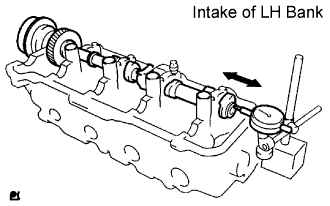 |
Check the gear backlash.
Install the drive gear to the camshaft timing tube.
Install the camshaft timing tube to the No. 3 camshaft.
Install the No. 3 camshaft and No. 4 camshaft without installing the camshaft sub-gear and front bearing cap.
Using a dial indicator, measure the backlash.
- Standard backlash:
- 0.020 to 0.200 mm (0.0008 to 0.0079 in.)
- Maximum backlash:
- 0.30 mm (0.0188 in.)
- If the backlash is greater than the maximum, replace the drive gear and No. 4 camshaft.
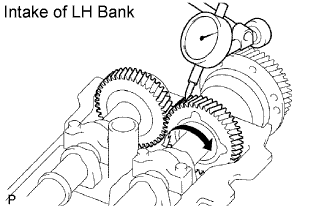 |
Remove the No. 3 camshaft and No. 4 camshaft.
Remove the camshaft timing tube from the No. 3 camshaft.
Remove the drive gear from the camshaft timing tube.
| 13. INSPECT NO. 4 CAMSHAFT SUB-ASSEMBLY |
Inspect the circle runout.
Place the camshaft on V-blocks.
Using a dial indicator, measure the circle runout at the center journal.
- Maximum circle runout:
- 0.08 mm (0.0031 in.)
- If the circle runout is greater than the maximum, replace the No. 4 camshaft.
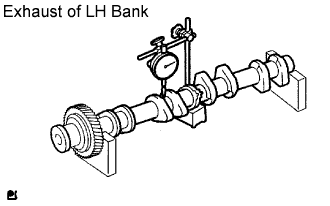 |
Using a micrometer, measure the cam lobe height.
- Standard cam lobe height:
- 42.630 to 42.730 mm (1.6783 to 1.6823 in.)
- Minimum cam lobe height:
- 42.48 mm (1.6724 in.)
- If the cam lobe height is less than the minimum, replace the No. 4 camshaft.
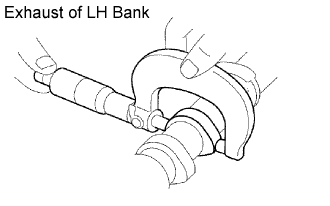 |
Using a micrometer, measure the journal diameter.
- Journal diameter:
- 26.954 to 26.970 mm (1.0612 to 1.0618 in.)
- If the journal diameter is not as specified, check the oil clearance.
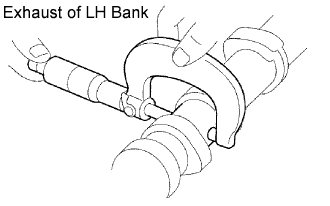 |
Check the oil clearance.
Clean the bearing caps and journals.
Check the bearings for flaking and scoring.
- If the bearings are damaged, replace the bearing caps and cylinder head as a set.
- If the bearings are damaged, replace the bearing caps and cylinder head as a set.
Place the No. 4 camshaft on the cylinder head.
Lay a strip of Plastigage across each of the journals.
Install the bearing caps.
- NOTICE:
- Be careful not to turn the No. 4 camshaft.
Remove the bearing caps.
Measure the Plastigage at its widest point.
- Standard oil clearance:
- 0.030 to 0.067 mm (0.0012 to 0.0026 in.)
- Maximum oil clearance:
- 0.100 mm (0.0039 in.)
- If the oil clearance is greater than the maximum, replace the No. 4 camshaft. If necessary, replace the bearing caps and cylinder head as a set.
Completely remove the Plastigage.
Remove the No. 4 camshaft.
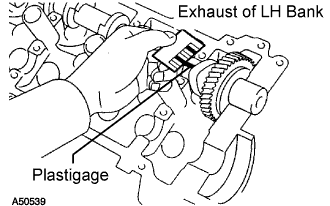
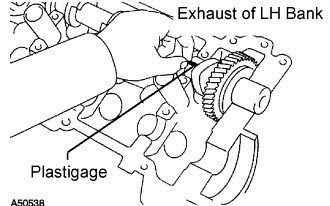 |
Check the thrust clearance.
Install the camshaft.
Using a dial indicator, measure the thrust clearance while moving the No. 4 camshaft back and forth.
- Standard oil clearance:
- 0.030 to 0.075 mm (0.0012 to 0.0030 in.)
- Maximum oil clearance:
- 0.12 mm (0.0047 in.)
- If the thrust clearance is greater than the maximum, replace the No. 4 camshaft. If necessary, replace the bearing caps and cylinder head as a set.
Remove the No. 4 camshaft.
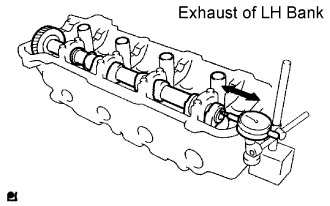 |
| 14. INSPECT CYLINDER HEAD SET BOLT |
Using a vernier caliper, measure the thread outside diameter of the bolt.
- Standard outside diameter:
- 9.770 to 9.960 mm (0.3846 to 0.3921 in.)
- Minimum outside diameter:
- 9.70 mm (0.3819 in.)
- If the diameter is less than the minimum, replace the bolt.
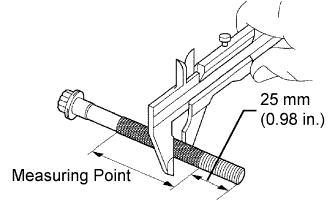 |